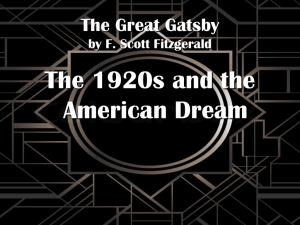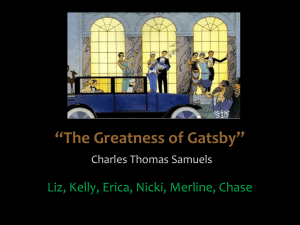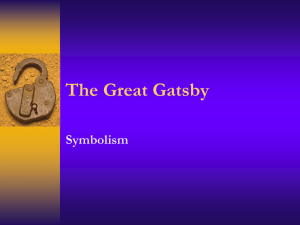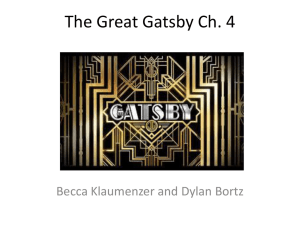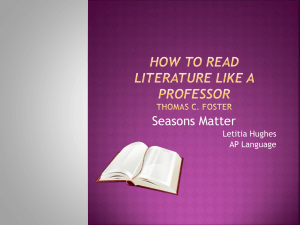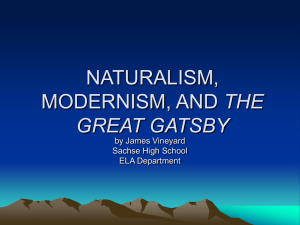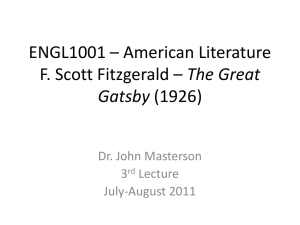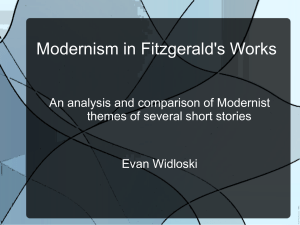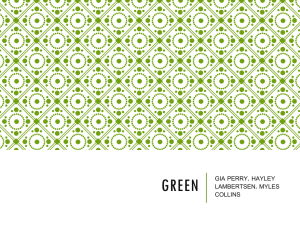The Great Gatsby: Finish
advertisement
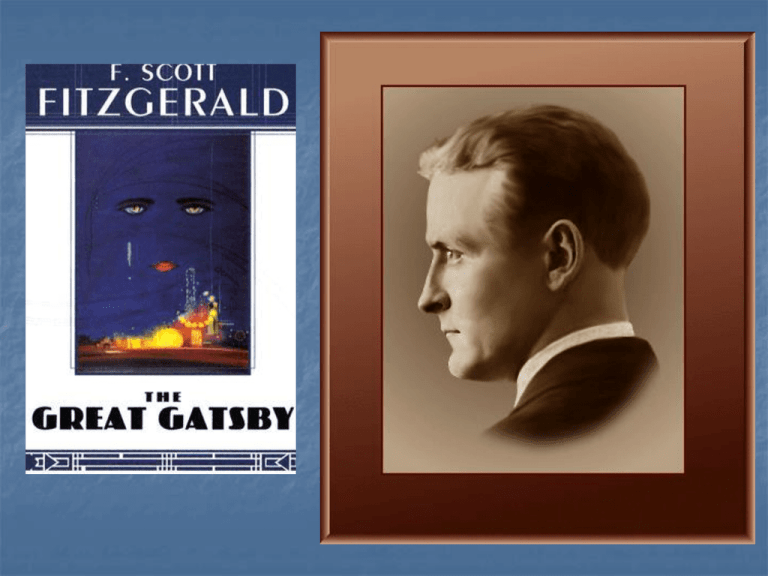
The Great Gatsby: Finish Theme: Corruption of the American Dream: The passage on page 189: Fitzgerald paints a picture of the American Dream at its height, suggesting that subsequent versions of the dream could only be realized in America’s increasingly corrupt materialism. That materialism is represented by the “inessential houses” that clutter the once-pure landscape. “Gatsby becomes an archetypal figure who betrays and is betrayed by the promises of America.” – biographer Matthew Bruccoli The Great Gatsby: Finish Juxtaposition: The passage on pages 183-84: This represents an abrupt shift in the narrative from the bleakness of the present to nostalgia for the past. It reemphasizes the contrast between illusion and reality. The Midwest, which Nick was glad to leave, now seems to him to be safe and happy and filled with camaraderie, especially compared to Gatsby’s rainy, bare funeral. The Great Gatsby Consider this final statement from Nick in Chapter 9 (the last question on your Chapter 9 study guide): “Gatsby believed in the green light, the orgiastic future that year by year recedes before us. It eluded us then, but that’s no matter – tomorrow we will run faster, stretch out our arms farther … And one fine morning – so we boat on, boats against the current, borne back ceaselessly into the past.” (189). Why is this quote significant to the theme of the American Dream in this novel? The Great Gatsby Gatsby’s struggle is related to his idealism; his faith in life’s possibilities, which is at the core of the American Dream: Gatsby believed in the green light, the orgiastic future that year by year recedes before us. Daisy represents a way of life which is so different from Gatsby’s and, thus, more attractive because it is out of reach. Gatsby struggles to fit into another social group, but he is also obsessed with doing so because his whole faith in life depends on it. His whole career, confidence in himself, and confidence in life is shattered when he fails to win Daisy. His death is almost insignificant; he is already spiritually dead when his dream collapses. This spiritual death also applies to the corruption of values, which is also related to the American Dream. Nick recalls the early idealism of the first settlers: an idealism that has been replaced by materialism, greed and spiritual emptiness. Fitzgerald stresses the need for hope and dreams to give meaning and purpose to our efforts: Tomorrow we will run faster, stretch out our arms farther … And one fine morning – Gatsby, with his “extraordinary gift of hope,” seems to achieve a heroic greatness, especially when compared to the empty existence of Tom and Daisy Buchanan. The Great Gatsby Yet, there is something almost pitiful about the way Gatsby refuses to grow up: to attempt the impossible by repeating the past: So we boat on, boats against the current, borne back ceaselessly into the past.” (189). In the end, the failure of hopes and dreams – of Gatsby’s failed dreams of Daisy, of the American Dream itself – is unavoidable. It bears repeating that reality cannot keep up with ideals because ideals are usually too fantastic to be realized in the first place. The Great Gatsby: Finish In August, 1924, Fitzgerald wrote, “That’s the whole burden of this novel – the loss of those illusions that give such color to the world so that you don’t care whether things are true or false as long as they partake of the magical glory.” The Great Gatsby: Exam Review CHARACTERIZATION: Know each character, their key actions, and key quotations. Example: “I don’t want you to get a wrong idea of me from all these stories you hear.” You will have a series of questions or descriptions with a number after each one. That number represents how many characters from the provided list fit that question or description. Example: Is mentioned in the title of the book (1). DETAILS: Recognize the significance of Fitzgerald’s descriptive, sensory details. How do those details help paint a picture? What do they show? Review Chapter 3 carefully. The Great Gatsby: Exam Review SYMBOLISM Understand what cars symbolize in the novel. LITERARY ELEMENTS AND TECHNIQUE: Be able to identify flashback, dialogue, symbol, irony, description. Example: The green light at the end of Daisy Buchanan’s dock: _____. VOCABULARY: Review the lists; there will be 7 words in matching format. THEME: Be able to analyze potential thematic concepts we’ve covered in the PowerPoint notes, such as hope, illusion, paradox, corruption of the American Dream. The Great Gatsby: Exam Review There will be an essay question asking you to compare and contrast plot, themes, and characters in “Winter Dreams,” The Great Gatsby, and “The Sensible Thing.” Look for parallels between the three. Determine how the two short stories serve as blueprints for Gatsby, particularly in how they address hopes, dreams, and love. You can use the book and the short stories for the essay answer, so expectations will be high. The Great Gatsby: Exam review In your essay analyses: Reference specific passages from the works to support your points when possible. For example, use Nick’s words to help prove your point about Gatsby’s “greatness”: “It was an extraordinary gift for hope” (6). Complete your thoughts. If you state that you agree with Nick’s assertion that you can’t repeat the past, finish that thought by stating how that connects to Gatsby, i.e., “It was this ill-fated and stubborn clinging to the past – a past that never really existed in the first place – that doomed Gatsby’s dream of Daisy and, by extension, his version of the American Dream. His inability and unwillingness to look ahead, instead of behind, meant he would always be purposely drifting, boating against the currents of the past instead fording the promise of the future. The Great Gatsby: Exam review Make your observations, but then link them to the novel: “The American Dream is an illusion, instead of something that can be achieved and obtained. This is the dynamic at work for Gatsby. His American Dream is contingent upon an illusion of Daisy, rather than the reality of her: an illusion that can never be achieved, especially given Daisy’s vacuous lack of purpose.”
